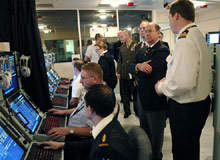
In March 2008, Admiral Gary Roughead, chief of US Naval operations, suggested that reducing crew sizes should assume top priority when it comes to upgrading old ships or building new ones (this was alongside technological advances and life-extending repair work).
“There’s no question that crew sizes have got to come down,” Roughead said, and with a new generation of vessels such as the Zumwalt Class destroyers – the US Navy’s largest surface warships since the Second World War – having a crew of just over 140, his thinking was clear.
The key was not so much in terms of how many people are onboard, so much as how effectively they are used. The new littoral combat ships, for example, will have a crew of just 40 – performing several tasks aboard – and training will clearly be a significant factor in achieving this multi-functionality.
Defence re-evaluations never used to focus so heavily on staff. In the past they often focused on the hardware, equipment and systems necessary to meet the challenges faced by the fast-evolving and ever more uncertain global stage. But today, the repercussions on human resources have become ever-more clear as shifts in military and geo-political thinking shape the tangible response to changing issues of national defence and the projection of power.
How well do you really know your competitors?
Access the most comprehensive Company Profiles on the market, powered by GlobalData. Save hours of research. Gain competitive edge.

Thank you!
Your download email will arrive shortly
Not ready to buy yet? Download a free sample
We are confident about the unique quality of our Company Profiles. However, we want you to make the most beneficial decision for your business, so we offer a free sample that you can download by submitting the below form
By GlobalDataNavies are now realising that while an increased operational tempo obviously puts pressure on maintenance and logistics, it also impacts on recruitment, training and redeployment schedules. Increasingly tasked with doing more, often with fewer people, many of the world’s forces are being forced to examine how they can retrain and retain existing personnel to ensure that full crews can be mustered across the service to meet times of crisis. One solution is to cut manning levels.
A multifunctional crew
Addressing the changing demands of naval in-service training / retraining naturally tends to be reactive but there is an obvious advantage in getting close to – and ideally, ahead of – the curve. This challenge has been taken up by the US Navy with its ‘revolution in training’ initiative, which aims to ensure that a properly trained sailor will always be in the right place, at the right time. It’s an ambitious goal which, according to Captain Gary Dye, US Navy training command chief of staff, is intended to “align both mission focus and resources with validated fleet requirements and priorities.”
Turning these words, first spoken to Nato’s research task group on recruiting and retention of military personnel in 2004, into a reality has required a major reappraisal of the pre-existing naval training – and a significant streamlining. This kind of analysis revealed, for example, large areas of skills overlap in eight electronics and technical ratings, enabling them to be combined into a single programme – making major cost and time savings in delivery.
The naval skills shortfall
In the current global engineering crisis, unsurprisingly, many of the world’s navies have found themselves suffering along with industry in general – but probably none more so than the Australian Navy. Many skilled naval technicians have been lured away by the lucrative remuneration packages offered by mining companies in Western Australia, leaving the service facing its greatest manpower shortage in a generation.
In April 2008, chief engineer, Commodore Peter Marshall, wrote “I do not need to tell you how bad our engineering manning issues are – suffice to say that most of our categories are categorised as critical with the submarine categories assessed as perilous.”
Headline news of only three crews for the country’s six Collins Class submarines coupled with skills shortfalls running at 35% for marine engineers, nearly 30% for weapons electrical engineers and 16% for principal warfare officers clearly cannot be allowed to persist.
The immediate response has been substantial bonuses for qualified submariners who stay on – A$60,000 apiece for an 18-month extension – but as Defence Minister, Joel Fitzgibbon, made clear in September, it is unlikely the navy will ever be able to match private sector salaries. However, solving the problem in the long term is likely to require a different approach, and policies described as ‘new and innovative’ are under development, with a novel package of retention initiatives expected to be announced in a forthcoming white paper in March 2009.
Australia is scarcely unique; the situation is similar for other Indo-Pacific navies too. New Zealand’s ‘defence sustainability initiative’, for example, aims to find 1,500-2,000 new recruits by 2015, while India is introducing new courses at the naval academy at Ezhimala to address technical officer shortages. How successful such efforts will ultimately be – and their knock-on effect on operations – remains to be seen.
Retaining human resources
Some defence analysts have started turning their eyes towards South Africa for an indication of how successful these kinds of initiatives might prove. Like Australia, many skilled workers have been lost to other industries, the words of South African navy chief, Vice Admiral Johannes Mudimu – “we cannot compete with private-sector salaries,” – resonating with the sentiments expressed by Fitzgibbon.
To counter this steady erosion of personnel, at the end of 2007, the navy began implementing a range of internal programmes to address their mounting skills deficit and the whole recruit / retrain / retain issue.
According to Lieutenant Commander Prince Tshabalala, external communications staff officer, they include “the continued recruitment of young men and women under the auspices of the military skills development programme, targeted recruitment of young people with tertiary qualifications, and also of divers and submariners.”
Alongside this comes an ongoing commitment to the retention of human resources, with a strategy specifically designed to examine and address all of the factors influencing the service’s persistent haemorrhage of personnel.
In addition, this approach recognises the importance of training and education in crewing high-technology vessels and keeping up to date with increasingly complex systems. This had led to the adoption of comprehensive training and retraining, especially in the technological sphere, broadly echoing the US ‘trained sailor / right place / right time’ ethos, and affording high priority to in-service skills development – which is the pre-cursor to true multifunctionality.
Although it is too soon to see the impact any of the strategies currently being espoused by world’s navies will have in terms of their operational roles over the coming years, the key issues are defined well enough. With a global scarcity in engineering disciplines and economic competition from the private sector rampant, being able to ensure a full crew mandates a serious reappraisal of human resource usage. One thing is clear, if the initiatives do ultimately fail to stem the flow in any significant way, many navies will be facing the spectre of reduced operational capacity – and for most, that would be simply unconscionable.




